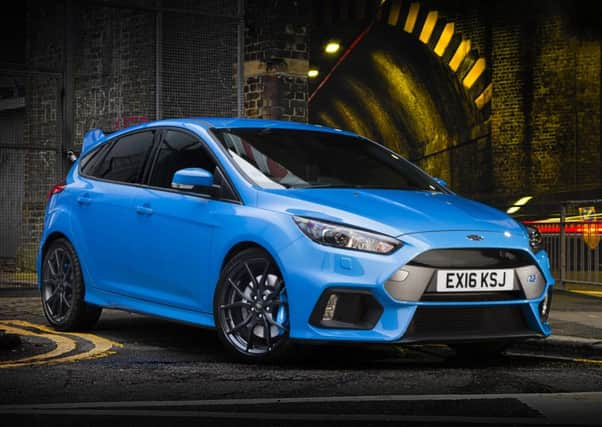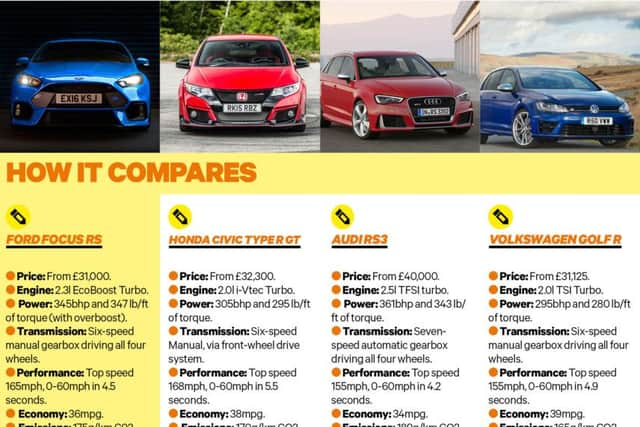Is the Ford Focus RS the ultimate hot hatch for everyday driving?


Instinct did indeed take over and, as the back end of the 350 PS ultra hatch kicked out around the corner on a modest drift, my instincts screamed at me to drive to the back of the queue of journalists — all waiting for their turn around the bend— for another go.
Is the ‘drift’ button a gimmick? You’d certainly be mad to ever use it on the road. Ditto launch control — which allowed lead-footed old me to tear off up the track like Lewis Hamilton — but the Focus RS isn’t just a car for the road. It’s a car that sits on the line between track car and everyday driver, before screaming off in a cloud of tyre smoke — or like a family hatch, whatever floats your boat.
Advertisement
Hide AdAdvertisement
Hide AdI was able to experience both faces of Dr Jekyll and Mr Hyde, with a two-hour cruise through the Cotswolds — to sample the car in the wild — acting as a prelude to six laps around the track followed by some drift tuition.


On the road, the hot Focus does as good a job as any car I’ve driven at being all things to all men. Driven conservatively in ‘normal’ driving mode, you could easily forget that you have 345 BHP at your disposal. Some of the engineering required to keep this car from biting your face off is incredibly clever but, despite torsional stiffness 23 per cent better than the standard Focus overall and 200 per cent stiffer in key areas of the rear subframe, the RS loses none of the everyday practicality that has made the Focus such a smash hit for Ford since its launch.
In ‘Sport’ mode, the all-wheel drive system (AWD), steering and engine response improve, the traction control gives a sportier experience and the exhaust begins to pop and spit like an angry tom cat.
Ford Performance have put a lot of work into that exhaust system, redesigning it three times to ensure it complies with noise and emissions regulations while still delivering maximum power and an engine note that does the twin-scroll turbocharged powertrain justice.
And the exhaust system isn’t the only thing that’s had a lot of love during the design process. The front suspension is 33 per cent stiffer than what you’ll find in the Focus ST, 38 per cent at the rear. The AWD system — which uses torque vectoring (dual-clutch) rather than a more traditional haldex set up — was redesigned in order to better handle the power after the first dual-clutch unit they used at the rear ate itself during testing. It’s got the biggest intercooler they could fit — and it’s so efficient that they actually had to tone down its performance in order to prevent water vapour entering the system.


The results are spectacular when you put your foot down. The car corners like a go kart, the torque vectoring directs power to the outside wheels during cornering to minimise understeer, preventing you from losing speed as you exit the bend. The suspension and stiff chassis help you keep things controlled while the AWD drive system ensures all that torque — 440nm, 470 with overboost — does what it’s supposed to do.
Tyrone Johnston, global vehicle and engineering manager for the Focus RS, headed up the development team. Fresh off the back of acting as chief engineer on Ford’s racing division, working on F1 and rally cars, he explained how the overboost function works: “We’re only allowed to say on the spec sheet that the Focus RS generates 440nm of torque because the overboost function only runs for 15 seconds at a time.
“In practice though, the system only takes one millisecond to recycle, so, if you lift your foot off the gas to let it do that you’re back to 470nm of torque.”
Advertisement
Hide AdAdvertisement
Hide AdVisually it looks the part too. Arguably, the latest RS is less flamboyant and—whisper it —more grown-up looking than its predecessor. It only comes in five-door variant to fit in with Ford’s ‘one Ford’ policy and keep costs down on the production line.
Ford are very proud of the fact that all the external flourishes that mark the Focus RS out from the run-of-the-mill model — with the exception of the badge — are purely functional. The gaping front grille is designed that way so as to provide maximum airflow to the intercooler. Either side, next to the front fog lights, vents channel air to the brake cooling system to improve stopping performance. The prominent spoiler to the rear of the car, coupled with the front splitter and rear diffuser help stick the car to the road and achieve ‘zero lift’ at speeds of up to 155mph. Upgrading from the multispoke 19-inch alloy wheels to the black forged alloys will not only add style points, but will reduce the car’s kerbweight by 4.3kg.
If all this seems like overkill for a car that legally shouldn’t be driven any faster than 70mph on British roads, this probably isn’t the car for you. Gone are the days when manufacturers could call something a hot hatch and get away with simply chucking in a few extra horses and some red decals. The modern petrolhead wants more and Ford — and Honda, Audi and VW of course — are out to deliver.
Ford Performance have three classes of car. There’s HB2, which includes the Fiesta ST, Focus ST and the Ford Mustang, there’s the ‘elite’ category, which is what you’re buying into if you buy the Ford GT supercar. The Focus RS— and also the Shelby GT350 Mustang — are part of the HB1 class.
To qualify for the HB1 rating, Ford chiefs say a car needs to be sophisticated and robust enough to be driven on a racetrack for 30 minutes straight in ‘track’ mode with no ‘de-rates’ in performance. In short, it needs to be able to withstand being driven like a race car.
And having driven the Focus RS as the engineers intended — okay, having sincerely tried to drive it as the engineers intended — I confirm that it works just as well on the track as it does on the road. Freed from any inhibitions over pedestrian safety, or other road users, the performance is staggering. The stopping power from the 350mm Brembo disks meant I could brake later going into corners than I had any right to be able to and, thanks to the torque vectoring tech, I was able to maintain more speed as I exited, shedding less momentum battling understeer.
I’ll be honest, I couldn’t tell you how fast I got the car up to, I was too busy concentrating on not smashing the £34k (as driven) car into a wall of tyres as the instructor barked things like ‘apex’ and ‘use all the track’ and ‘lift the clutch, you idiot’. It feels properly quick though and on the straights of the racetrack the acceleration felt relentless and uncompromising.
The concept of the hot hatch has evolved since engineers in the 70s and 80s started tinkering with more powerful variants of everyday road cars. The hyper hatch is here and the Focus RS is a prime example of this new breed of vehicle — all the power and thrills of a hardcore track car, with all the benefits of a family hatch.
If I had £31,000 to spend on a car right now, I would join the 3000-strong line of prospective owners and get my order in today.